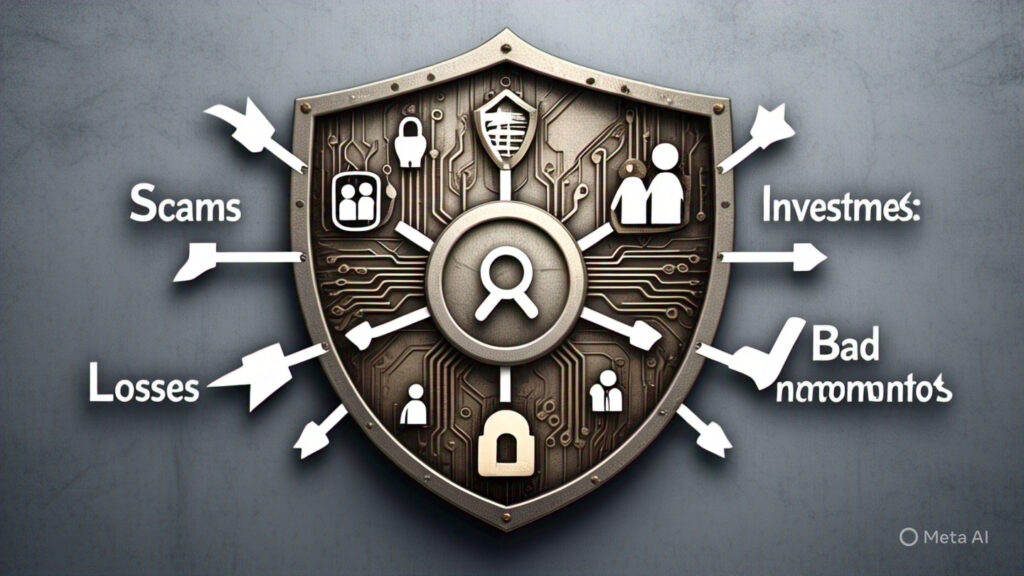Introduction: Navigating the Wild West of Crypto with Eyes Wide Open
The world of cryptocurrency can feel like the digital Wild West – full of exciting opportunities, groundbreaking innovations, and the potential for significant gains. But just like the old frontier, it also harbors risks, scams, and projects that might not be what they seem. In this dynamic and often unregulated landscape, one skill stands out as your most crucial asset: due diligence (DD).
Think of due diligence as your personal compass and shield in the cryptoverse. It’s the process of thoroughly researching and investigating a cryptocurrency project, exchange, or any other crypto-related venture before you invest your hard-earned money or entrust your valuable time and resources. Skipping this vital step is akin to blindly crossing a busy street – the potential for getting hurt is significantly higher.
This article will illuminate why due diligence isn’t just a suggestion in the crypto world; it’s an absolute necessity. We’ll break down what it entails, the key areas you need to investigate, and provide practical tips to help you develop a robust due diligence process. By understanding and implementing thorough research, you can significantly mitigate risks, make more informed decisions, and navigate the exciting but sometimes treacherous terrain of cryptocurrency with greater confidence and security.

Why Due Diligence Isn’t Just a Buzzword: Protecting Yourself in a Decentralized World
In traditional finance, regulatory bodies and established institutions provide a degree of oversight and protection for investors. However, the decentralized nature of cryptocurrency often means fewer safeguards and a greater reliance on individual responsibility. This is where due diligence becomes paramount:
- Protecting Your Capital: The primary reason for conducting due diligence is to protect your financial investments. The crypto market is volatile, and not every project will succeed. Thorough research helps you identify potential red flags and avoid scams or poorly conceived ventures that could lead to significant losses.
- Identifying Scams and Fraudulent Schemes: The anonymity and rapid growth of the crypto space have unfortunately attracted malicious actors. Due diligence helps you spot Ponzi schemes, pump-and-dump operations, and other fraudulent activities designed to steal your money.
- Understanding the Technology and Fundamentals: Investing in a cryptocurrency or project without understanding its underlying technology, whitepaper, team, and use case is like buying a car without knowing if it has an engine. Due diligence helps you assess the viability and potential of the project.
- Evaluating the Team and Community: The success of a crypto project often hinges on the competence and integrity of its team and the strength of its community. Due diligence involves researching the team’s background, experience, and reputation, as well as gauging the sentiment and engagement of the community.
- Assessing the Tokenomics: The tokenomics – the economics of a cryptocurrency’s supply, distribution, and utility – can significantly impact its long-term value. Due diligence involves analyzing the token distribution, inflation rate, and the token’s role within the ecosystem.
- Understanding the Regulatory Landscape: Cryptocurrency regulations are still evolving and vary significantly across jurisdictions. Due diligence involves understanding the legal and regulatory implications for the projects you are considering.
- Mitigating Emotional Decision-Making: The hype and volatility of the crypto market can often lead to emotional investment decisions driven by FOMO (Fear Of Missing Out) or panic selling. Thorough due diligence helps you base your decisions on logic and research rather than emotions.

The Pillars of Due Diligence: Key Areas to Investigate
Conducting effective due diligence involves exploring several key areas. Here’s a comprehensive breakdown of what you should investigate:
1. The Whitepaper and Project Documentation: The Blueprint
The whitepaper is a foundational document that outlines the project’s goals, technology, use case, team, tokenomics, and roadmap. It’s the first place you should look to understand the project’s vision and how it intends to achieve its objectives.
- What to Look For:
- Clarity and Coherence: Is the whitepaper well-written, easy to understand, and free of technical jargon without proper explanation?
- Realistic Goals: Are the project’s aims achievable and grounded in reality?
- Problem-Solution Fit: Does the project clearly identify a problem and offer a viable blockchain-based solution?
- Technology Explanation: Is the underlying technology explained in sufficient detail, and does it seem sound and innovative?
- Tokenomics Breakdown: Is the token distribution, supply, and utility clearly explained?
- Roadmap and Milestones: Does the project have a realistic development roadmap with achievable milestones?
- Team Introduction: Are the team members clearly identified with their relevant experience?
- Red Flags:
- Vague or Unrealistic Promises: Be wary of projects promising unrealistic returns or revolutionary solutions without clear technical backing.
- Plagiarism or Lack of Detail: A poorly written or plagiarized whitepaper is a major red flag.
- Overly Complex or Confusing Language: While some technical complexity is expected, excessive jargon without clear explanation could be intentional obfuscation.
- Missing or Incomplete Information: A whitepaper lacking crucial details about the technology, team, or tokenomics should raise concerns.

2. The Team and Advisors: The Driving Force
The team behind a cryptocurrency project is crucial to its success. Researching their backgrounds, experience, and reputation is essential.
- What to Look For:
- Relevant Experience: Do the team members have relevant experience in blockchain, technology, finance, or the industry the project aims to disrupt?
- Public Profiles and Track Record: Are their professional backgrounds and past projects verifiable through platforms like LinkedIn? Do they have a positive track record?
- Transparency and Communication: Is the team transparent about their roles and actively engaged with the community?
- Advisory Board: Does the project have reputable advisors who lend credibility and expertise?
- Red Flags:
- Anonymous or Pseudonymous Team Members: While Satoshi Nakamoto’s anonymity is an exception, a team that hides their identities without valid reasons should raise suspicion.
- Lack of Relevant Experience: A team with no prior experience in the relevant fields may struggle to execute the project.
- Questionable Track Record: Research if team members have been involved in unsuccessful or controversial projects in the past.
- Lack of Communication: A team that is unresponsive to community inquiries or lacks transparency is a cause for concern.

3. The Technology and Innovation: The Engine
Understanding the underlying technology and its potential is vital.
- What to Look For:
- Novelty and Innovation: Does the project offer a unique technological solution or a significant improvement over existing technologies?
- Scalability and Efficiency: Is the technology designed to be scalable and efficient enough to handle its intended use case?
- Security Measures: What security protocols are in place to protect the network and user funds?
- Open Source and Audits: Is the code open source and has it been audited by reputable third-party security firms?
- Testnet and Development Activity: Is there a working testnet, and is the development team actively working on the project (check GitHub activity)?
- Red Flags:
- Vague or Unsubstantiated Technical Claims: Be skeptical of projects making grand technological claims without providing sufficient technical details or evidence.
- Lack of Innovation: Is the project simply a copycat of existing projects without offering any unique value?
- Closed Source and Lack of Transparency: A lack of transparency about the codebase can hide potential vulnerabilities or malicious code.
- No Working Product or Testnet: A project that has been around for a while without a working product or even a testnet should raise concerns about its viability.

4. The Community and Sentiment: The Ecosystem
The strength and sentiment of the project’s community can be an indicator of its adoption potential and long-term viability.
- What to Look For:
- Active and Engaged Community: Is there an active and growing community on platforms like Telegram, Discord, Twitter, and Reddit?
- Genuine Interest and Support: Is the community genuinely interested in the project’s goals and providing constructive feedback?
- Healthy Discussion and Debate: A healthy community allows for critical discussion and isn’t just an echo chamber of hype.
- Red Flags:
- Small or Inactive Community: A lack of community engagement could indicate a lack of interest in the project.
- Fake or Bot-Driven Engagement: Be wary of communities with suspiciously high numbers of followers or engagement that appears artificial.
- Suppression of Criticism: A project that aggressively silences criticism or bans dissenting opinions may have something to hide.
- Cult-like Behavior and Unrealistic Hype: Excessive hype and a lack of critical thinking within the community can be a warning sign.

5. Tokenomics: The Economic Engine
Understanding how the cryptocurrency’s tokens are distributed, their supply, and their utility within the ecosystem is crucial for assessing its potential value.
- What to Look For:
- Fair Distribution: Was the initial token distribution fair and equitable? Are there any signs of excessive insider allocation?
- Supply Schedule: What is the total supply of the token, and what is the emission schedule (how new tokens are created)? Is it inflationary or deflationary?
- Token Utility: What is the purpose of the token within the project’s ecosystem? Does it have real utility that drives demand?
- Staking or Governance Mechanisms: Does the token offer opportunities for staking rewards or participation in governance?
- Red Flags:
- High Inflation Rate: A high inflation rate without sufficient utility can lead to price depreciation.
- Concentrated Ownership: A large percentage of the tokens held by a small number of individuals or entities can lead to market manipulation.
- Lack of Utility: A token with no clear use case within the ecosystem may struggle to gain value.
- Ponzi-like Tokenomics: Be wary of projects that heavily rely on new investors to drive up the price for early adopters.

6. Regulatory Landscape: The Rules of the Game
The regulatory environment for cryptocurrencies is constantly evolving and can have a significant impact on the success and legality of projects.
- What to Look For:
- Compliance Efforts: Is the project taking steps to comply with relevant regulations in different jurisdictions?
- Legal Opinions: Has the project sought legal counsel to ensure its operations are within the bounds of the law?
- Transparency with Regulators: Is the project transparent in its dealings with regulatory bodies?
- Red Flags:
- Ignoring Regulations: Projects that openly disregard regulations may face legal challenges and potential shutdowns.
- Operating in High-Risk Jurisdictions: Be cautious of projects primarily operating in jurisdictions with unclear or hostile regulatory environments.
- Securities Law Violations: Does the token offering potentially qualify as an unregistered security?

7. Security Audits and Vulnerabilities: Protecting the Fortress
For established projects, reviewing security audit reports conducted by reputable third-party firms is crucial.
- What to Look For:
- Reputable Auditors: Were the audits conducted by well-known and respected security firms?
- Audit Findings and Remediation: What vulnerabilities were identified, and how were they addressed by the project team?
- Ongoing Security Efforts: Does the project have a continuous security monitoring and improvement process?
- Red Flags:
- Lack of Audits: A project that hasn’t undergone security audits, especially if it handles user funds, is a major red flag.
- Unaddressed Vulnerabilities: If audits have identified significant vulnerabilities that haven’t been fixed, it poses a serious risk.
- History of Hacks or Security Breaches: Past security incidents should be carefully considered.

Practical Tips for Conducting Effective Due Diligence
- Start with Skepticism: Approach every crypto project with a healthy dose of skepticism. Don’t get caught up in hype or promises of guaranteed returns.
- Cross-Reference Information: Don’t rely on a single source of information. Verify claims and information across multiple reputable sources.
- Take Your Time: Due diligence takes time and effort. Don’t rush the process.
- Document Your Research: Keep records of your findings and the sources you consulted.
- Seek Diverse Opinions: Engage with the community and other investors, but always form your own independent conclusions.
- Understand Your Risk Tolerance: Even after thorough due diligence, all investments carry risk. Only invest what you can afford to lose.
- Stay Updated: The crypto landscape is constantly changing. Continuously monitor the projects you’ve invested in and be aware of new developments.

Conclusion: Your Responsibility in the Decentralized Revolution
In the decentralized world of cryptocurrency, you are your own bank and your own regulator. While the potential rewards can be significant, so too are the risks. Thorough and consistent due diligence is not just a recommended practice; it’s your fundamental responsibility as a participant in this exciting but often unpredictable market.
By taking the time and effort to research and understand the projects you are considering, you empower yourself to make more informed decisions, protect your capital, and navigate the cryptoverse with greater confidence and security. Due diligence is the unsung hero of crypto investing – your shield against scams, your compass guiding you towards viable projects, and ultimately, your key to a more secure and successful journey in the digital frontier. So, before you take the plunge, remember to look closely, ask questions, and always, always do your own research.



